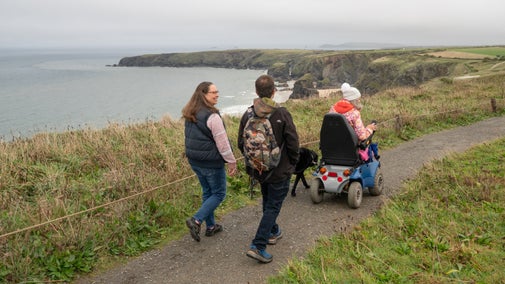
Discover more at Carnewas at Bedruthan
Find out how to get to Carnewas at Bedruthan, where to park, the things to see and do and more.

Carnewas at Bedruthan has a strong mining history as the area was a hive of industrial activity in the 19th century. While mining has long since stopped here, the buildings still stand as a reminder of this local history. Bedruthan had a very different reputation as a holiday resort in the Victorian era. There's also a mysterious legend around the back stacks at Bedruthan.
Carnewas was a hub of industrial activity in the 19th century, although not much is known about the mining that took place here. It's thought that miners tunnelled into the cliffs from the beach in search of iron, copper and lead.
Mining stopped many years ago, but the buildings are a reminder of this industry. The National Trust shop was once the count house or mine office and the café was also converted from mine buildings.

Bedruthan became a popular destination when Newquay developed as a holiday resort more than 100 years ago. Victorians visiting in their carriages found Bedruthan a convenient attraction, and the local savvy farmer responded to this interest by providing stalls for the horses on payment of a toll.
There's a legend about a giant called Bedruthan using the beach stacks as stepping stone as a short across the bay. However, this seems to be a late 19th-century invention. Sadly, no early reference to the story has been found.
The first recorded evidence of ‘Bedruthan Steps’ is in The West Briton of February 1847 and is likely to refer to the original cliff staircase. It's been suggested that the name ‘Bedruthan Steps’ was originally given to the staircase, but has since been applied to the whole beach and particularly the distinctive stacks.
The constant pounding of the sea on the coastline means that the rocks are ever-changing. The coast here has transformed throughout history. As the softer rock is eroded, the harder rocks are left in the forms of islets or stacks.
The rock known as Queen Bess Rock was named in the Victorian era, because people thought it looked like Queen Elizabeth I. However, erosion has since caused the rock to lose its 'head' into the sea.
Providing access to Bedruthan beach via a staircase has proved challenging throughout history. Since the 1960s, the stairs have been closed many times when no safe route was possible.
A generous benefactor gifted the National Trust £25,000 in 1973, to rebuilt the old cliff staircase. However, by 1990, further fragmentation of the cliff meant the staircase had to be closed. While it was re-opened in 1995, it has had to close again following a major rock fall in 2019.

Find out how to get to Carnewas at Bedruthan, where to park, the things to see and do and more.
A rock fall in 2019 means access to the beach at Carnewas at Bedruthan has been closed, while the National Trust consults with others on if a route could be safely reinstated in a sustainable way.
There's plenty to discover at Carnewas at Bedruthan, Cornwall. From exploring local history and cliff top walks to wildlife watching and stargazing, there's something for everyone.

Carnewas at Bedruthan is a two pawprint rated place. Dogs are welcome at Carnewas and Bedruthan. Here are some top tips if you are planning a visit with your dog.

Learn about people from the past, discover remarkable works of art and brush up on your knowledge of architecture and gardens.
